
http://www.iaeme.com/IJMET/index.asp 196 editor@iaeme.com
International Journal of Mechanical Engineering and Technology (IJMET)
Volume 10, Issue 03, March 2019, pp. 196–203, Article ID: IJMET_10_03_020
Available online at http://www.iaeme.com/ijmet/issues.asp?JType=IJMET&VType=10&IType=3
ISSN Print: 0976-6340 and ISSN Online: 0976-6359
© IAEME Publication Scopus Indexed
COST REDUCTION STRATEGIES AND THE
GROWTH OF SELECTED MANUFACTURING
COMPANIES IN NIGERIA
Ben-Caleb Egbide, Otekunrin Adegbola, Rasak Bamidele,
Adewara Sunday, Oladipo Olufemi
Landmark University Omu-Aran Kwara State, Nigeria
Eshua Ruth
Covenant University Ota Nigeria
ABSTRACT
The problem of high manufacturing costs has led to the shutdown of many
manufacturing companies in Nigeria. This study examines the relationship between
cost reduction strategies and the growth of manufacturing companies in Nigeria using
data from annual reports of 40 manufacturing companies quoted on the Nigeria Stock
Exchange within the period of 2012-2016. 40 manufacturing companies were sampled
purposively for this study. The study took changes in material cost, changes in labour
cost and changes in administrative overhead as variables for cost reduction strategies
while changes in turnover as the variable for Growth. Correlation analysis was
conducted to determine the association cost reduction strategies and growth while,
regression analysis was used to determine the impact of cost reduction strategies on
the growth of manufacturing companies. Results showed a positive significant
relationship between cost reduction strategies and growth of manufacturing
companies in Nigeria. The study recommends that manufacturing companies should
implement value analysis in order to reduce material costs and the implementation of
cost reduction strategies in all manufacturing companies in Nigeria.
Key words: Strategic Management Accounting, Cost reduction strategies, Value
analysis, Budget Discipline, Nigeria
Cite this Article: Ben-Caleb Egbide, Eshua Ruth, Otekunrin Adegbola, Rasak
Bamidele, Adewara Sunday, Oladipo Olufemi, Cost Reduction Strategies and the
Growth of Selected Manufacturing Companies in Nigeria, International Journal of
Mechanical Engineering and Technology 10(3), 2019, pp. 196–203.
http://www.iaeme.com/IJMET/issues.asp?JType=IJMET&VType=10&IType=3
1. INTRODUCTION
The growth of any company is largely determined by how well it can manage its costs. This is
partly because to be able to maximize profit, cost must be reduced to the bearest minimum.
Cost reduction has become a vital tool for companies to constantly stay ahead of the increased

Ben-Caleb Egbide, Eshua Ruth, Otekunrin Adegbola, Rasak Bamidele, Adewara Sunday, Oladipo Olufemi
http://www.iaeme.com/IJMET/index.asp 197 editor@iaeme.com
competition in the business environment (Alireza & Mahdi, 2012). Indeed, even organizations
that are gainful can profit by implementing cost-lessening techniques to make a considerably
higher overall revenue on its items or administrations. According to Ogunnaike (2010), the
effective and efficient management of cost is not only necessary to meet the profit objective
of the company but also the going concern status of the entity. To record growth in terms of
increase in profit of an organization, cost reduction mechanism should be put in place.
Chartered Institute of Management Accountants (CIMA), London defined cost reduction
as the achievement of real and permanent reduction in the unit cost of goods manufactured or
services rendered without damaging the ability of the product to serve the purpose for which it
was intended. According to Gaurav,Jain,Kapoor and Nateriya (2013), cost reduction is "the
way toward searching for, finding and expelling baseless costs from a business to build the
benefit without negatively affecting item quality". The concept of continuously searching for
new ways and avenue of reducing costs needs to be constantly promoted at all levels of an
enterprise, which signifies that the enterprise has a strategic approach to this issue (Figar&
Ivanoic, 2015).
Cost reduction strategies such as value engineering and value analysis, tight budgetary
control (budget discipline), target costing and life cycle costing can be adopted by
manufacturing companies to reduce the material cost, labor cost and productivity cost
attributed to manufacturing. This research is therefore concerned with the nexus between cost
reduction strategies and growth of manufacturing companies in Nigeria.
2. LITERATURE REVIEW
2.1. Concept of Cost Reduction
Low production costs has become one of the primary ways that organizations compete in a
global economy, hence, cost reduction must continually be in the minds of managers of
organization (McWatters, Morse, & Zimmerman, 2001). Cost reduction is a planned approach
to reduce expenditure. It is a continuous process of examining critically all elements of cost
and each aspect of the business with a view to improving business efficiency. cost reduction is
a corrective function. Cost reduction is the process of cutting down costs incurred by an
organization for the purpose of making profit. It starts when cost control ends and considers
that no cost is at its optimum level. According to Adeniyi (2001), cost reduction starts with an
assumption that current cost levels or planned cost levels are too high despite the fact that cost
control may be good and organization experiencing high efficiency levels.
2.2. Concept of Growth
According to Webster dictionary, growth is defined as the process of growing, progressive
development, increase and expansion. Growth is a positive change in size over a period of
time. Growth is defined as a gradual development in maturity, age, size, weight or height.
In Economics, growth is seen as increase in the capacity of an economy to produce goods
and services compared from one period of time to another. According to Amadeo (2017), an
economy is said to be growing if it produces more than it did in the prior period. According to
the economists, Growth connotes two things; increase in the output produced by an economy
over time and increase in what an economy is able to produce using all its scarce resources.
Business dictionary defined business growth as the process of improving some measure of
a firm’s success. It refers to progressive development in a business specified by either
increase in size or expansion. Pitch Partner Growth opined that there is no specific definition
for business growth; as it could mean a lot things ranging from sales growth, market
expansion and business value growth. Benchmarking your company against competitors,

Cost Reduction Strategies and the Growth of Selected Manufacturing Companies in Nigeria
http://www.iaeme.com/IJMET/index.asp 198 editor@iaeme.com
using industry average to assess business growth, monitoring the growth of workforce,
evaluating gross margin growth, evaluating net margin growth and examining company’s
market share growth are ways business growth is measured(Arthur, 2016).
In the view of Gupta, Guha and Krishnaswami(2013),growth can be defined in terms of
revenue generation, value addition, and expansion in terms of volume of the business. Growth
can also be measured using qualitative features like market position, quality of product, and
goodwill of the customers. Most times when businesses record increase in sale of its products
causing increase in income generation, it is said that the company is growing(Arthur,2016).
Growth has become the quest of all business owners because of reasons such as; responding
to market demand, increase in profit and attaining business stability. This is because as
businesses become large they can maximize and benefit from economies of scale, bulk
discounts and better supplier credit terms, which mean cost, are driven down and profits
increased.
2.3. Relationship between Material Costs and Sales Growth
A hike in the prices of materials or components required to make product leave businesses
with no choice than to increase the price for their products. The aim of the seller is to make
profit on the sale of his items; this leads him to raise the product price to cover for the extra
cost incurred by him in acquiring materials while maintaining the level of profit (Tepper,
2017). Usually, the market reaction to an increase in price is reduced sales, as customers in
their rational nature will always go for a product when the price is low than when its
increases. As long as customers continue to act rationally, an increase in price of products will
reduce the amount of sales to be made. This fall in sales has an adverse effect on the growth
of a company because a company can not grow without making sales. Constantly, revenue
increase is a typical indicator of financial wellbeing of a company. As a matter, of fact,
revenue is made from sales and profit is derived from the revenue by deducting all costs,
hence, no/low revenue, and no profit.
2.4. Relationship between Labour Costs and Turnover
Labour costs forms a significant portion of overheads of most businesses regardless of
whatever industry they belong to(Tonkins, 2016). Since labour costs form a significant
portion of business costs, increased labour costs increases the cost of doing business and these
cost is transferred to customers in high prices. According to the law of demand which states
that the higher the price the lower the demand and vice versa, sales will reduced because of
the increase in price. Therefore, it can be said that labour costs affect business turnover(sales).
Since manufacturing companies need increased sales to experience growth, hence, it can be
conclusively said that labour costs affect the growth of companies.
2.5. Cost reduction Strategies
2.5.1. Kaizen Costing
Kaizen costing is the procedure of constant cost lessening that happens when a product is in
the production stage. It is a process of continuous improvement that empowers steady
decreases in cost by fixing the standard (Adeniji, 2011). It is a procedure for decreasing cost
which centers around the creation procedure and accomplishes cost reduction by essentially
expanding the productivity of the generation procedure (Asaolu & Nassar, 2007). Kaizen is
authored from two words: KAI which signifies "change" and ZEN which signifies "for better"
(Rof, 2012). Kaizen is a Japanese expression for making upgrades to a procedure in little
incremental sums instead of through substantial developments. Kaizen’s incremental

Ben-Caleb Egbide, Eshua Ruth, Otekunrin Adegbola, Rasak Bamidele, Adewara Sunday, Oladipo Olufemi
http://www.iaeme.com/IJMET/index.asp 199 editor@iaeme.com
approach is considered appropriate because products are already in the manufacturing process
making it difficult to make large changes to reduce costs.
2.5.2. Value Analysis
Value analysis is one of the major cost reduction techniques. It is an organized method of
identifying and eliminating unnecessary costs associated with product or service by
conducting an analysis of function of each component of the product. It is an almost universal
method used for analyzing existing products and services offered by production companies
with basic principle of offering value for the lowest or optimal production costs (Leber,
Bastic, Marvic, & Ivanisevic, 2013). It is an approach to improving that focuses on improving
the value of an item or process by understanding its constituent’s components and their
associated costs. It is an organized examination of every item of cost which goes into
production. The very core of VA is the effort to determine and eliminate those
characteristics of products or services with no real value for the customer or the product, but
which, nevertheless, cause costs in the production process or service delivery(Leber et al,
2013).
2.5.3. Budgetary Control
The process by which future spending plans are compared with the actual performance to find
out variances is termed budgetary control. It alludes to how managers effectively utilize
budgets to screen and control costs within a given timeframe Budgetary control guarantees
that the targets of the budgetary plans are achieved (Assaolu.T.&Nassar.M, 2007). Budgetary
control systems cover all phases of business activity, sales, production, administration and
finance and serves as a yardstick for comparison (Collier, 2015). It is a strategy for reducing
cost that disengages issues by concentrating on those variances which serve as warning
signals to managers. It controls cost by limiting the allowable expenses for different
departmental heads, hence, costs are not expected to exceed certain levels. The hallmark of
Budgetary control is to achieve profit maximization through appropriate coordination of
various capacities, legitimate control of capital and income consumptions and making greatest
utilization of accessible assets (Preetabh, 2010).
2.6. Theoretical Review
2.6.1. Going Concern Theory
The going concern principle states that an entity will continue actively in business for the
foreseeable future and will not be forced to bring its operations to a stand still or have its
assets liquidated (The going concern principle, 2017). Theory of going concern refers to the
ability of a company to make enough money to stay afloat without having to go bankrupt. The
theory is premised on the assumption that an enterprise will continuously carry out its
operating activities for a period of time that is sufficient enough to meet its obligations and
commitments as they fall due. In other words, it is presumed that the company would have no
reason to liquidate or be forced out of business in the foreseeable future. Since it is assumed
that a company will not be forced to halt operations, then management will have to make
provisions to curb anything that will negate such assumption.
Rising costs is the major factor that affects the going concern status of a business
organization as uncontrolled cost can force a company to halt operations. Uncontrolled costs
affect the ability of the company to make profit, thus, without profit company can not fulfill
its obligations, neither can it experience growth.

Cost Reduction Strategies and the Growth of Selected Manufacturing Companies in Nigeria
http://www.iaeme.com/IJMET/index.asp 200 editor@iaeme.com
2.6.2. Neo-classical Growth Theory
Neo classical growth theory summaries how a stable growth rate can be achieved with the
proper amount of three powerful forces: labour capital and technology. The theory states that
varying the amounts of labour and capital in a production function leads to a state of
equilibrium. It emphasizes that three factors influence the growth of an economy (Otekunrin,
A.O., Nwanji, T.I., Olowookere, J.K., Egbide, Fakile, S.A., Lawal, A.I., Ajayi, S.A., Falaye,
A.J. & Eluyela, D.F., (2018)) .The theory also argues that technological change has a major
influence on an economy, and that economic growth cannot continue without advances in
technology. In manufacturing companies, three factors affect its capacity to grow; material
cost, labour cost and overhead expenses. These factors have a major influence on the profit
maximization ability of the firm, thus, hindering its ability to grow. Manufacturing firms will
experience growth if these costs can be rightly allocated, controlled and ultimately reduced. In
an economy where these costs are greatly affected by inflation, recession and other factors, a
strategy must be put in place to ensure that these costs do not exceed the bearable point.
2.7. Empirical Framework
Barbole,Yuraj, and Santosh(2013) conducted an examination on the impact of cost control
and cost reduction strategies on the manufacturing sector. Research findings show that cost
control and cost reduction activities are required for businesses to survive, grow and prosper.
They further explained several cost control and cost reduction tools and techniques and also
carried out an analysis of the changes that occur in component cost after implementing the
various techniques. The study is limited to material cost; it does not include labour costs and
other overheads in its analysis. The study therefore recommends that manufacturing
companies should make use of value engineering, budgetary control and quality control for
cost control and cost reduction in production plant.
The study of Oyerogba, Olaleye&Solomon (2014), examined the relationship between
cost management practices implemented by manufacturing firms and its. The study utilized
data from 40 manufacturing companies quoted on the stock exchange during the period of
2003-2012 for their analysis. Findings show that there exists a positive significant relationship
between cost management practices and firms performance in the manufacturing sector.
Empirical findings also showed that cost-effective manufacturing firms maintain low
administrative overhead cost. The study recommends the implementation of a cost reduction
strategy with emphasis on production and administrative overhead costs if manufacturing
firms intend to achieve their profit maximization and wealth creation objective. Lawal(2017),
discovered in his study that cost control has a positive impact on organizational performance.
He examined the effect of cost control and cost reduction technique on organizational
performance with major emphasis on budgetary control as an effective tool of cost reduction
and cost control. He viewed the importance of cost reduction scheme as something that can
not be overstated and suggests that companies undertake frequent examination of costs in
order to curb excessiveness, thereby, eliminating costs. It was concluded in his study that for
an organization to experience more profit growth by producing quality goods and services,
there is a need to control and reduce cost to the acceptable limit.
3. RESEARCH METHODS
This study investigated the relationship between cost reduction strategies and growth of
selected manufacturing companies in Nigeria by means of descriptive statistics. The study
adopted the use of secondary data which was extracted from the annual reports of the
selected companies. The statistical methods used in the analysis include the correlation and
regression analysis.

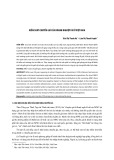
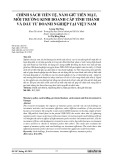
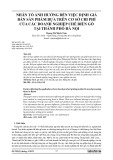

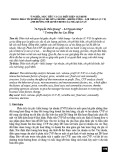

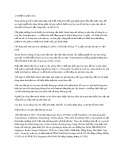


![Chiến lược giá: Tài liệu [mô tả/hướng dẫn/tổng hợp]](https://cdn.tailieu.vn/images/document/thumbnail/2015/20150122/anhduongit/135x160/4641421897150.jpg)















